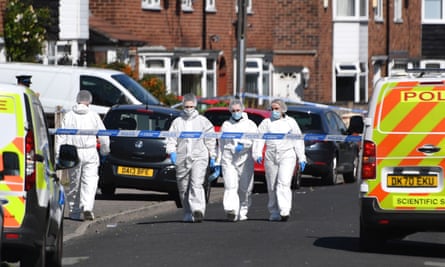“It’s sad to think that these are young people we’re talking about. A littered wasteland is part of their identity – they’re prepared to die for it,” says Robert Hesketh, a criminologist at Liverpool John Moores University.
He lives in North Huyton, an area he describes as very territorial – and he would know. He has spent his career researching Merseyside’s gangs.
He begins to list “the Hillsideheads, the Doveyheads, we’ve got the Mossheads – they’re really original with these names – there’s Princess Drive and that’s separate from the Wimborne gang”.
Having carried out interviews with countless local gang members over the years – particularly young people who are recruited into these criminal groups – Hesketh has an encyclopaedic knowledge of who owns which streets and what each gang is particularly known for.
“The Mossheads are probably the specialists in terms of firearms, the Wimborne gang it’s robberies and burglaries,” he explains.
Liverpool’s gangs have been the focus of national attention in the past week after the shooting deaths of three people, including the murder of nine-year-old Olivia Pratt-Korbel.
Though people have a loose idea of what is meant by a gang, the term is used to refer to all manner of groups. “Despite all of the years and all the research, no one has come up with a universal definition of what a gang is,” Hesketh says.
In the US, the Bloods and the Crips, who started in the Compton area of Los Angeles, have grown to be national organisations. “To me, they’ve outgrown the gang label, they’re going towards some form of insurgency,” he adds.
Liverpool is not easily compared to California though. “What we’ve got is more of a case of street gangs involving kids as you get closer to the night-time economy in the city centre, working under the influence of adult-organised crime,” he said.

In addition to the influencer lifestyle that having money can bring, youngsters are attracted to “the buzz, the adrenaline” of crime.
“When you think about it, these are guys who are living in a highly marginalised area, with that day-to-day boredom. So it’s the excitement. It’s not just when they commit the actual crime that they derive the excitement, it’s dressing the part, planning it, orchestrating it. And then after that, if they’ve actually got away with it, that’s an even bigger buzz that’s reinforced because they’ve got some form of financial or material benefit.”
Girls and young women play a part but gangs tend to be male-dominated and fuelled in part by a “masculinity crisis” among these young men. But rather than being caused by a lack of a father figure, Hesketh’s research instead identified poor role models. “It’s inappropriate father figures, so they were taking them out, and taking them to their mate’s flat, smoking weed, and the young child was exposed to all of this.”
For the young people who get involved in gangs, they often do so to exercise their entrepreneurial side in areas where there are few legitimate opportunities, especially for those who are not academic.
Groups such as the Doveyheads and the Wimborne gang are young people who grow up in those few streets, who wear branded jackets and go around on bikes, but “as you go towards Kensington and Anfield, the language among the young people involved becomes more businesslike and that’s where you see the influence of adult organised crime groups”.
“It’s the people you don’t see – some of them with nice houses in Southport or Crosby – those are the movers and shakers within organised crime,” he says.
The young people involved do not consider themselves part of a gang and they are more likely to think of gang activities, predominantly selling cannabis, as work.
Hesketh says: “Their job is to get the best product out there and market it as well. They don’t see it as criminality, they see it as a job. They’re sending out marketing texts: buy one get one free.”
